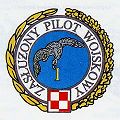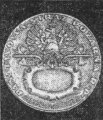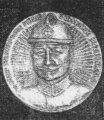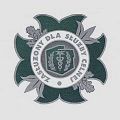 1.Badge (3 wounds)
1.Badge (3 wounds)|
ORDERS AND DECORATIONS OF POLAND Republic of Poland since 1990 (Click here to see updates) |
(Odznaka za Rany i Kontuzje)
Instituted by the State Defense Council on July 14, 1920, during the Polish-Soviet war . Conferred on all members of the Polish Armed Forces wounded or injured in action against an enemy, provided the injury required surgical treatment. It is equal in importance to the US Purple Heart Medal.
Badge: garter blue (light blue in People's Poland) ribbon bar with two narrow horizontal black pinstripes (colors of Virtuti Militari). A small five-pointed silver star is attached to the ribbon for each wound. All wounds sustained in the same action or battle count as one. The ribbon is worn directly above the upper row of decorations or ribbon bars. Until WW2 no more than three stars were allowed on a single bar. Additional stars were worn on another ribbon, placed above the first, and so on. This regulation was altered during WW2, and since then all stars are worn in a single row until the ribbon reaches the length of three or four standard ribbon bars.
 1.Badge (1 wound)
1.Badge (1 wound)(Wojskowa Odznaka za Rany i Kontuzje)
Instituted on August 19, 2011 as part of an Act on Veterans of Overseas Missions, and by Executive Order of Minister of National Defense of March 15, 2012. Awarded by the Minister of Defense to any member of the Polish Armed Forces wounded in action against an enemy, as a result of a terrorist attack or another event related directly to the mission out of country borders, provided the wound requires surgical treatment; or injured without the need of surgical treatment, provided the injury has resulted in permanent or temporary inability to fulfill military service.
Badge: dark blue ribbon bar, 40 x 10 mm, with two narrow horizontal crimson side stripes (colors of the Order of the Military Cross). A small five-pointed silver star is attached to the ribbon for each wound or injury. All wounds or injuries sustained in the same action or battle count as one. The ribbon is worn directly above the upper row of decorations or ribbon bars. When the number of stars exceeds three, the ribbon is wider by 14 mm per each additional star.
Note: The badge is similar to the Wound Badge of 1920, except the ribbon color.
 1.Badge
1.Badge(Odznaka "Zasluzony Pilot Wojskowy")
Instituted by Minister of National Defense onSeptember 14, 1999. The decoration replaced the title of Meritorious Military Pilot, awarded until 1992. The decoration is conferred to military pilots for acts of bravery while participating in an aerial flight, or for long and particularly outstanding service. It can be conferred up to three times on the same individual. The badge is worn on the right side of chest, above the upper pocket.
Badge: round medallion, 45 mm in diameter, of oxidized silver. In the center there is a pilot's eagle on light blue background, holding a gilt Roman numeral I, II or III in its beak, depending on the number of awards. It is surrounded by a white enameled ring, circumscribed ZASLUZONY PILOT WOJSKOWY, and with a white and red Air Force chessboard at the bottom. the whole is surrounded by a gilt wreath, half laurel, half oak. On the reverse side there is a screw for mounting.


 Gold Medal (15 years, 1951-59)
Gold Medal (15 years, 1951-59)
(Medal "Sily Zbrojne w Sluzbie Ojczyzny")
Instituted by act of Parliament of May 26, 1951. Conferred to professional officers and NCO's, for long and meritorious service in the armed forces, as well as to civilians working for the armed forces. The medal is conferred in three grades: gold, silver and bronze. The three grades were initially awarded for 15, 10 and 5 years of service. In 1960 the duration of service required for the gold and silver medal was extended to 25 and 15 years, while the bronze medal was discontinued (the gold medal was never awarded). The regulations were amended again in 1968, the medals began to be conferred by the Minister of National Defense, the years of service for the upper two grades being shortened to 20 and 10 years and the bronze medal for 5 years being restored. Conferment of the medals was temporarily suspended in 1990 but with new regulations of 1995 they are again awarded by the Minister of National Defense. The duration of service required to be eligible for the two highest classes has been extended again to 25 and 15 years.
Badge 1951-1990: gilt, silvered or bronze medal 34 mm of diameter. In the middle there is a non-crowned silver eagle on red enameled background, surroundes by a white enameled circle, circumscribed SILY ZBROJNE W SLUZBIE OJCZYZNY (armed forces in service for the country), and with a small five pointed star at the bottom. The whole is surrounded by a gilt, silver or bronze laurel wreath, superimposed on two crosses swords. At the bottom of the wreath there is a red enameled oval shield with Roman numerals XV, X, V (1951-1960), XXV, XV (1960-1968), or XX, X, V (1968-1990). The reverse is plain.
Badge since 1996: as above, but without the oval bottom shield. The eagle in the center has a crown.
Ribbon: 32-35 mm, red with double narrow white side stripes.



Note: the medal is still awarded, despite the renewal of the Long Service Medal in 2007.

 1.Obverse (gold)
1.Obverse (gold)(Medal Wojska Polskiego)
Instituted by act of Parliament of September 3, 1999. Conferred in three grades (gold, silver and bronze) to foreign nationals, military or civilian, who rendered merit in cooperation between the Polish Armed forces and the armed forces of other countries, in particular by supporting peacekeeping operations of the Polish Armed forces, rendered merit in the area of cooperation of international military units including Polish units, contributed to the growth of military potentioal of the Polish Armed Forces or to widespreading of Polish military history or traditions abroad. The medal is the counterpart of the Medal for Merit to Country Defense for foreigners.
Badge: gilt, silver or bronze medal, 36 mm in diameter. Obverse: red enameled cross pattée with slightly concave arm bases and with stylized rays between the arms. Under the arms there is a laurel wreath. Superimposed on the cross is a silver (irrespective of the grade) crowned eagle. Reverse:a two line insctiption WOJSKO / POLSKIE (Polish Army).
Ribbon: 38 mm, light brown with blue edges, separated by yellow gold pinstripes and with half white half red stripe in the center.




 1.Gold - (3rd Republic)
[Reverse]
1.Gold - (3rd Republic)
[Reverse](Medal Za Zaslugi dla Obronnosci Kraju)
Instituted by act of Parliament of April 21, 1966, altered 1991. Conferred in three grades by Minister of National Defense to military and civilians for meritorious activities to strengthen military power of the country.
Badge 1966-1991: gilt, silvered and bronze medal, 38 mm of diameter. Obverse: contour of Poland with a superimposed stylized Polish eagle sitting on the Amazon shield; the whole circumscribed by the inscription ZA ZASLUGI : DLA OBRONNOSCI KRAJU (for merit for defense of the country). Reverse: a three row inscription MINISTERSTWO / OBRONY / NARODOWEJ (Ministry of National Defense), circumscribed POLSKA RZECZPOSPOLITA LUDOWA (Polish People's Republic).
Badge since 1991: gilt, silvered and bronze medal, 36 mm of diameter. Obverse: a semicircular shield with a crowned eagle sitting on the Amazon shield, surmounted by a closed knight's helmet; the whole surmounted by the inscription ZA ZASLUGI DLA : OBRONNOSCI KRAJU. Reverse: a two row inscription WOJSKO / POLSKIE (Polish Army), with an ornament above and below.
Ribbon: 38 mm, red with broad white edges.




 1. obverse (Gold)
1. obverse (Gold)(Medal za Zaslugi dla Policji)
Instituted by decree of the President of the Republic of June 7, 2001. Conferred in three grades (gold, silver and bronze) to a policeman or policewoman in recognition of his/her merit in service or in recognition of securing public order. It can also be bestowed upon a non-policeman, for cooperation and assistance to the police. It is conferred by the Minister of the Interior. The medal replaced the Decoration for Merit in Protection of Public Order, conferred in People's Poland.
Badge: gold, silver or bronze medal, 37 mm in diameter. Obverse: a silver (irrespective of the grade) eight pointed police star, with a silver state eagle superimposed on it, below the eagle there is an enameled blue scroll with the word POLICJA (police) upon it. The star is transfixed by two crossed swords (pointing downwards) of white and red blades, and surrounded by a closed oak wreath. Reverse: a three-line inscription MEDAL / ZA ZASLUGI / DLA POLICJI (medal for merit to the police) with an oak leaf above and below.
Ribbon: 40 mm, blue with a wide red central stripe and narrower white side stripes. .




 1.Obverse
1.Obverse(Medal honorowy im. Jozefa Tuliszkowskiego)
Instituted by decision of the Chief Commandant of the Professional Fire Services of October 11, 1993. It is the highest award that can be conferred to members of the Professional Fire Services for at least 25 years of outstanding service or presented exceptional courage in action. In exceptional cases the medal can be conferred to Fire Service Units. The medal is named in honor of a pioneer of Polish firefighting, and Chief Commandant of the Fire Services. corresponds to the Boleslaw Chomicz Medal awarded to members of the Voluntary Fire Services.
Badge: round bronze table medal, 80 mm in diameter. Obverse: the head of Jozef Tuliszkowski in a helmet, with the year 1867 on the left and 1939 on the right, all circumscribed JOZEF TULISZKOWSKI PIONIER POLSKIEGO POZARNICTWA (Jozef Tuliszkowski, pioneer of Polish Fire Services). Reverse: a crowned eagle with two fire hooks and two axes in claws and a helmet, sitting upon an oval cartouche with the place to engrave a recipient's name; with the inscription PANSTWOWA STRAZ POZARNA RP (Professional Fire Services of the Republic of Poland) around.

 1.Obverse (gold - People's Republic)
1.Obverse (gold - People's Republic)(Odznaka "Zasluzony dla Ochrony Przeciwpozarowej")
Instituted on February 27, 1984 by Minister of the Interior. Discontinued about 1990 and renewed in the altered form on October 16, 1997. Conferred in three grades to members of the Professional Fire Brigades, Voluntary Fire Brigades and people who are not members of the above, for courage and sacrifice in action, during a fire, flood or another disaster; for particular merit for fire protection and for outstanding service in the Professional Fire Brigades.
Badge 1984: a gilt, silver or bronze medal, 36 mm of diameter. The obverse a Maltese cross with a helmet, eagle's head and laurel spray in the center. Around there is a ring circumscribed ZA ZASLUGI : DLA OCHRONY PRZECIWPOZAROWEJ (for merit in fire protection). The reverse bears the four line inscription W / SLUZBIE / LUDOWEJ / OJCZYZNY (in service of people's country). The ring contains a laurel wreath and the letters PRL below.
Badge 1997: a gilt, silver or bronze Greek cross, 44 x 44 mm, with slightly concave arm bases. Under the cross there is an oak wreath. Superimposed is another cross with concave arms and arm bases, covered with red enamel. In the center there is a silver crowned eagle with spread wings, with a parade helmet on his chest an two fire axes in his claws. On the reverse there is the four line insctiption ZA / RATOWANIE ZYCIA / I / OCHRONE MIENIA (for life saving and protection of property).
Ribbon 1984: official - 36 mm, red with white (inner) and blue (outer) edge stripes; ribbon 1997: 40 mm, with a blue stripe in the center turning into white on the sides and broad red edge stripes with darker edges. In practice the decoration is worn on a ribbon with a dark blue stripe in the center, flanked by narrower bright blue ones and white pin stripes, and with red edges.







 1.Obverse (gold)
1.Obverse (gold)(Medal za Zaslugi dla Strazy Granicznej)
Instituted on October 8, 2004. Conferred in three classes (gold, silver and bronze) to members of the Frontier Guard for merit to this service, preventing crimes whose fighting is a statutory task of the Frontier Guard or cooperation with other countries' frontier services. It can also be awarded to non-members of the Frontier Guard and foreign nationals.
Badge: a gilt, silver or bronze medal, 35 mm of diameter. The obverse a green enameled Maltese cross with ball finials and a silver (irrespective of class) crowned Polish eagle with a border pole behind superimposed on the center. The cross is surrounded by a laurel and oak wreath. The reverse bears an outline map of Poland, inscribed: "Za Zaslugi / dla / Strazy Granicznej" inside.
Ribbon: 35 mm, green with a white-red-white central stripe, 15 mm wide.



 1.Badge
1.Badge(Odznaka Strazy Granicznej)
Instituted by Minister of the Interior on March 17, 1997. Conferred in a single grade to members of the Frontier Guard for at least four years of excellent service, particularly meritorious service or accomplishment of an assignment in difficult circumstances. It can be conferred only once to the same person.
Badge: an openwork oval badge, 47 x 37 mm, made of oxydized silver metal. In the center there is a crowned eagle in front of a frontier post enameled white and red. The whole is surrounded by a half laurel half oak silver wreath. At the bottom there are entwined gilt letters SG (Straz Graniczna - frontier guard). On the other side there is a screw for mounting. The badge is worn on the uniform.

 1.Decoration 1974-90 (bronze)
1.Decoration 1974-90 (bronze)(Odznaka "Zasluzony dla Sluzby Celnej")
Instituted by decision of Government of April 22, 1974, originally as the Decoration for Customs Merit of the People's Republic of Poland (Odznaka "Za zaslugi dla celnictwa PRL") in three grades: gold, silver and bronze. Suspended in 1990, it was reintroduced and amended by the Act on Customs Service of July 24, 1999 and the regulation of the Prime Minister of April 17, 2000. The new decoration is conferred in a single grade to members of Customs Service, Frontier Guards, as well as other individuals who have rendered merit to Polish Customs. The decoration is conferred by the Minister of Finances on suggestion of the President of the Central Customs Office. On the uniform the badge is worn on the right chest pocket.
Badge 1974-90: octagonal, similar to a cross, rotated 45 degrees. The "arms" of this cross are covered with dark green enamel. Between them there are stylized oak leaves. The round central shield bears an outline map of Poland, also covered with dark green enamel, with a Caduceus (the symbol of the Customs Administration), encircled by laurel and oak sprays. A white enameled circle bears the inscription ZA ZASLUGI DLA CELNICTWA : PRL. The reverse is blank.
Badge 2000: fork cross of silver gray metal, 35 mm in diameter, with the arms covered with dark green enamel and alternate oak and laurel sprays between them. The medallion is as above, bur the white enameled circle bears the inscription ZASLUZONY DLA SLUZBY CELNEJ.
On the reverse there is a screw for mounting.Ribbon 1974-90: 37 mm, green with a wide red central stripe and narrower white side stripes.
![]()
![]()
![]()

 1. obverse (Gold)
1. obverse (Gold)(Odznaka "Zasluzony Policjant")
Instituted by regulation of Minister of the Interior of July 4, 2000. Conferred in three grades (gold, silver and bronze) to a policeman or policewoman, initially in recognition of his/her merit in service or in recognition of securing public order. Since the institution of the Medal form Merit to the Police in 2001, it has been conferred for long, exemplary service in the Police. The decoration replaced the Decoration for Merit in Protection of Public Order, conferred in People's Poland.
Badge: gold, silver or bronze medal, 37 mm in diameter. Obverse: a silver (irrespective of the grade) eight pointed police star, with a silver state eagle superimposed on it, below the eagle there is an enameled blue scroll with the word POLICJA (police) upon it. The star is surrounded by a closed oak wreath. Reverse: a two-line inscription ZASLUZONY POLICJANT (meritorious policeman).
Badge: dark blue with red (inner) and white (outer) edges.




 1.Obverse (gold)
1.Obverse (gold)(Odznaka "Za Zaslugi w Pracy Penitencjarnej")
Instituted by decision of the Minister of Justice of April 26, 1996, replacing the old Corrections Long Service Decoration. It is conferred in three grades (gold, silver and bronze) to members of Correctional Service for long and outstanding work. The gold grade can be awarded more than once.
Badge: gold, silver or bronze medal, 35 mm in diameter. Obverse: a crowned state silver eagle (in all classes) on red enameled background. Around there is a non-enameled ring inscribed MINISTER SPRAWIEDLIWOSCI - ZASLUZONEMU (Minister of Justice - for merit). Reverse: the emblem of the Polish Correctional Service - crossed sword and torch in a half oak half laurel wreath, with a three line inscription PENITENCJA / PRACA OSWIATA / KULTURA (corrections, labor, education, culture) on it. Ribbon: 35 mm, dark blue with two white stripes and white (inner) and red (outer) edges.





 [Badge 1960-72]
[Badge 1960-72]Instituted on December 12, 1972 by Minister of Justice as a pin decoration, it replaced the old one class badge established 1960 and conferred for 5 years of exemplary service. On November 23, 1977, it was converted to a medal. Awarded in three grades for 25, 15 and 10 years' service respectively. In 1985 service periods were reduced to 15, 10 and 5 years respectively.
Badge 1960: 25 x 30 mm, in the form of an irregular oval, depicting crossed sword and torch and with the letters S(luzba) / W(iezienna - corrections service) in the center. The oval is encircled by the inscription ZA WZOROWA SLUZBE (for exemplary service) with two laurel sprays at the edges and surmounted by a stylized uncrowned eagle. The badge was worn on the right chest pocket of the uniform.
Badge 1972: 30 x 45 mm, gilt, silver or bronze, semicircular, with the crossed sword and torch in an oak wreath, surrounded by the inscription W SLUZBIE PENITENCJARNEJ (in the corrections service); the whole is surmounted by a stylized eagle, separated from the bottom by an enameled bar with three dark blue and two red stripes. The badge was worn on the right chest pocket of the uniform.
Badge 1977: gilt, silver or bronze medal, 32 mm of diameter. Obverse: crossed sword and torch in an oak wreath, with Roman numerals XXV, XV and X respectively above, and surrounded by the inscription W SLUZBIE PENITENCJARNEJ. Reverse: three line inscription ZA / WZOROWA Z SLUZBE, encircled by MINISTERSTWO : SPRAWIEDLIWOSCI (ministry of justice).
Badge 1985: as above but with the numerals altered to XV, X and V respectively.
Ribbon (since 1977): 32 mm, dark blue with two white stripes.


